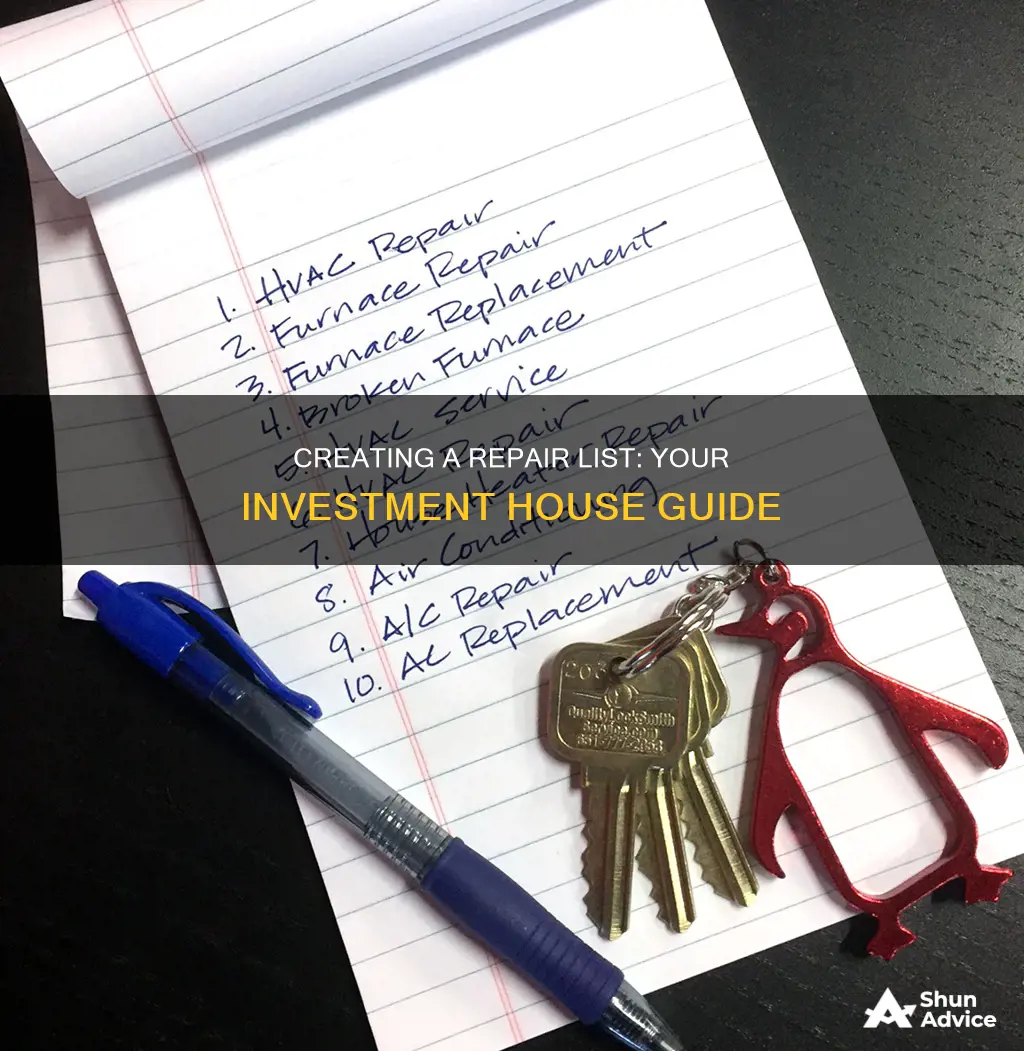
Creating a repair list for an investment property is a crucial step in real estate investing. Whether you plan to flip the house or rent it out, a comprehensive repair list helps you estimate costs, make profitable investments, and ensure tenant satisfaction. The first step is to identify costly repairs and damages, such as issues with the roof, plumbing, HVAC system, windows, doors, flooring, and paint. It's important to note that this is not a detailed punch list for contractors but a way to gauge the overall cost of renovations. You should also pay attention to safety and structural aspects, such as water damage, termite infestations, and poor insulation. By creating a repair list, you can make more confident offers on investment properties and maximize your chances of a profitable flip or rental.
| Characteristics | Values |
|---|---|
| Structure | Wall, ceiling, floors |
| Kitchens | New appliances, updated countertops, refinished cabinets |
| Bathrooms | Updated sink and counters, tiles, lighting |
| Bedrooms | Flooring, storage options, windows and window treatments |
| Heating and Cooling Systems | HVAC |
| Plumbing | Water heater, pressure relief valve, intake screen, irrigation systems |
| Electricals | Smoke detectors, carbon monoxide detectors, fire extinguishers, lighting |
| Exterior | Roofing, gutters, windows, doors, paint |
| Interior | Walls, flooring, ceilings, appliances, fixtures |
What You'll Learn
- Check the exterior for missing windows, broken glass, roof damage, etc
- Inspect the interior for water damage, holes in walls, necessary painting, etc
- Check the kitchen for broken appliances, cabinet doors, and the condition of the countertops
- Examine the bathrooms for broken fixtures, cabinets, toilets, and showers
- Inspect the heating and cooling systems, plumbing, and electrical systems

Check the exterior for missing windows, broken glass, roof damage, etc
Checking the exterior of an investment property for any issues is crucial, as it can help you identify problems that may affect the property's value and your potential returns. Here are some detailed steps to guide you through the process of checking the exterior for missing windows, broken glass, roof damage, and other issues:
Inspect the Roof:
- Look for any missing shingles, gaps around vents, or debris on the roof.
- Check for signs of water damage, such as pooling water or soft spots.
- Inspect the gutters and downspouts for any blockages or damage.
- Ensure that the roof is in good condition and there are no leaks.
Windows and Glass:
- Check all windows for any cracks, broken panes, or shattered glass.
- Look for stress cracks, which start small around the edges of the window frame and can lead to a network of fractures if not repaired.
- Identify pressure cracks, commonly found on insulated glass or double-pane windows, which break in an hourglass shape and require immediate replacement.
- Inspect window frames for any separation or soft spots, which could indicate water damage or the presence of mold.
- If there are too many cracks, consider using cardboard or plywood to cover the window temporarily, taping the edges to prevent further damage.
Exterior Walls and Siding:
- Examine the exterior walls for any damage, including holes, cracks, or signs of water damage.
- Check the siding or exterior finish for any loose panels, peeling paint, or other issues.
- Look out for signs of pest infestations, such as termite damage, which can affect the structure's integrity.
- Ensure the walls are in good condition and address any issues promptly.
Doors and Garages:
- Inspect all exterior doors, including garage doors, for proper sealing and functionality.
- Check for gaps or damage around the door frames and ensure the doors open and close smoothly.
- If there are glass panels in the doors, make sure they are intact and not broken.
Landscaping and Outdoor Areas:
- Assess the condition of the landscaping, including trees, shrubs, and plants.
- Look for any dead or overgrown areas that may need trimming or removal.
- Check outdoor lighting fixtures and ensure they are functioning properly.
- Inspect driveways, sidewalks, and exterior building surfaces for any damage or wear and tear.
Remember, addressing exterior issues promptly is crucial to maintaining the value of your investment property and ensuring the safety and satisfaction of your tenants or potential buyers.
A Guide to Investing in India's Wedding Hall Industry
You may want to see also

Inspect the interior for water damage, holes in walls, necessary painting, etc
Water damage is a common issue in homes and can lead to the growth of mould, which is hazardous for inhabitants. It is important to fix the cause of the water damage first, whether that be a leaking pipe or a leak from outside the property, such as a gutter or downspout.
To inspect the interior for water damage, holes in walls, necessary painting, etc., follow these steps:
- Check for water stains on the walls and ceilings. If there is a water stain, assess whether the drywall is soft or hard to the touch. If it is soft, it will need to be replaced by a professional before painting. If it is hard, you can move forward with a primer and paint.
- If there is mould or mildew, clean the area with a diluted mixture of chlorine bleach and water, then allow it to dry.
- Apply a water-based primer/sealer to the area. This will help keep the wall from getting water damaged again and allow the paint to stick better. Let it dry and then recoat for a better seal.
- Smooth over any damaged or sagging areas of drywall with medium-grit sandpaper.
- If there are any holes in the walls, fill them and sand them down before painting.
- Choose your paint. It is important to use a water or oil-based primer if covering water damage, as regular paint will bleed through.
- If there are any baseboards or pieces of crown moulding with water damage, these may need to be replaced, as the glue that holds these particle boards together reacts to water, causing them to swell.
- If the property is located in an area with high humidity, consider using paint designed to inhibit mould growth.
- If there are any structural issues with the walls, such as cracks or damage, these will need to be repaired before painting.
Smart Investing Guide: 10 Lakhs in India
You may want to see also

Check the kitchen for broken appliances, cabinet doors, and the condition of the countertops
When checking the kitchen of an investment property, it's important to thoroughly assess the appliances, cabinet doors, and countertops for any issues. Here's a detailed guide to help you through the process:
Appliances:
- Check if all the essential appliances are present, such as a refrigerator, stove, oven, and dishwasher.
- Look for any visible signs of damage or wear and tear on the appliances. This includes dents, scratches, or broken components.
- Test the appliances to ensure they are functional. Try opening and closing the refrigerator door, turning on the stove, and running the dishwasher to ensure they are in good working order.
Cabinet Doors:
- Inspect the cabinet doors for any physical damage, such as cracks, chips, or warping.
- Ensure that the doors open and close smoothly and that the hinges and handles are secure and functional.
- Check for signs of water damage, especially under the sink and around pipes.
- Assess the overall condition of the cabinets. Look for signs of aging or deterioration, such as peeling paint, faded finishes, or outdated styles.
Countertops:
- Examine the countertops for any visible damage, including cracks, chips, stains, or scratches.
- Assess the type of material used for the countertops. Common materials include granite, marble, laminate, wood, tile, or stainless steel, each with its own set of advantages and disadvantages.
- Evaluate the condition of the material. For example, with granite or marble countertops, check if they need to be resealed to prevent bacteria from penetrating the surface.
- Consider the overall style and appearance of the countertops. Outdated or worn countertops may need to be replaced to improve the aesthetics of the kitchen.
Remember to be thorough in your inspection and take notes on any issues you find. Creating a detailed repair list will help you prioritize the necessary improvements and budget accordingly for your investment property.
Private Equity's Commercial Building Investment Strategies
You may want to see also

Examine the bathrooms for broken fixtures, cabinets, toilets, and showers
When examining the bathrooms of an investment property, it is important to pay close attention to detail to ensure you don't miss any issues. Broken fixtures, cabinets, toilets, and showers can be costly to repair or replace, so it is essential to carefully inspect each element.
First, check the fixtures. Are there any signs of water damage, such as discolouration, rotting wood, softening materials, or mould? Pay particular attention to the areas around the fixtures, joints, and seams, as water is most likely to escape from these areas. Look for leaks, including from the showerhead or taps, and check the condition of the caulking and grout. If the caulking is damaged or the grout is missing, this can lead to water damage and costly repairs. Inspect the shower door seals and drain assemblies, as these are common sources of leaks.
Next, examine the cabinets. Are they in good condition, or do they need to be replaced? A simple refresh, such as a new coat of paint and updated hardware, can make a big difference. If the cabinets are messy or outdated, consider replacing them with new ones or opting for a more modern, sleek design.
Then, inspect the toilet. Look for any cracks in the toilet tank or bowl, as well as loose or damaged supply line connections. Listen for constant running water, which could indicate a leak, and check for water pooling around the base. Toilet leaks can waste water and cause damage to the floor, so it is important to address any issues promptly.
Finally, assess the shower. Check for any cracks or damage to the shower floor or walls, and ensure that the showerhead is functioning properly. If the shower is leaking, it could be due to cracked or loose tiles, a damaged shower door seal, or worn-out caulking. Inspect the area around the shower for signs of water damage and ensure the shower is properly sealed to prevent further issues.
By thoroughly examining the fixtures, cabinets, toilets, and showers in the bathrooms, you can identify any necessary repairs and make informed decisions about your investment property.
Managing Investment Risk: Strategies for Success
You may want to see also

Inspect the heating and cooling systems, plumbing, and electrical systems
Inspecting the heating, cooling, plumbing, and electrical systems is a crucial aspect of making a repair list for an investment house. Here is a detailed guide to help you through the process:
Plumbing:
Plumbing is one of the most important considerations when investing in a house. Many homeowners overlook plumbing issues, which can lead to costly repairs or replacements later on. To create a comprehensive repair list, follow these steps:
- Check for leaky toilet bases. Inspect for warping or discolouration around the toilet's base, soft or movable floors, or a rocking or sliding toilet bowl.
- Inspect the sewer system. Ask about the type of sewage system the house has, its location, size, and the most recent service date. Look for signs of seepage, such as bad odours or standing water.
- Evaluate the plumbing pipes. Determine the pipe sizes and consult a professional or research to assess if there are issues with water pressure. Older homes may have galvanized pipes that corrode faster, leading to low water pressure.
- Inspect under the sinks. Look for new pipes, especially in older homes, as contractors often install plumbing pipes in walls during construction, and going through walls for fixes can be more costly and labour-intensive.
- Check the water meter. Ensure no water is running in the house, then check if the dial is moving, indicating a potential leak.
- Assess the water colour. Discoloured water, even if it's just a faint brown or yellow, could be a sign of rusting pipes.
- Pay attention to the water heater. Find out its location and assess if a leak could cause property damage. Look for corrosion or buildup on the pipes and connections, and inquire about the unit's service history.
- Test showers for leaks. For metal showers, run the water and replace if leaking. For glass door showers, point the showerhead at the intersection of the door and wall, and caulk the inside if there is a leak. For tiled floor showers, fill the shower with water to check for leaks, as they can be difficult to detect.
- Inspect sinks for leaks. Fill the sinks with water, then allow them to drain to detect any leaks. Check the drain stopper, as it is a common location for sink leaks.
- Be mindful of lead in plumbing pipes. Lead was commonly used in plumbing pipes in older homes, and it can be harmful to health. Use a lead testing kit or consult a professional to determine if the pipes contain lead.
Heating and Cooling Systems:
When inspecting the heating and cooling systems, it is essential to seek professional assistance to ensure a thorough evaluation. Here are some general aspects to consider:
- Identify the type of heating and cooling systems installed in the house.
- Assess the condition and age of the systems. Older systems may be less efficient and more prone to breakdowns.
- Check for any signs of damage or corrosion on the external components of the systems.
- Review the maintenance history to understand the care and repairs done on the systems.
- Ensure the systems are functioning properly by testing them during the inspection.
- Inquire about the energy efficiency of the systems, as outdated systems may result in higher utility costs.
- Consider the size and capacity of the systems relative to the house's size to ensure adequate heating and cooling.
Electrical Systems:
Inspecting the electrical systems is crucial to ensure safety and functionality. Here are the key areas to focus on:
- Check for visibly damaged wiring, including frayed cables, chew marks from rodents, or tangled and messy wiring.
- Inspect outlets and switch plates for excessive heat. If they feel hot to the touch, it indicates faulty wiring.
- Pay attention to frequently blown fuses or tripped breakers, as it could be a sign of wiring problems or overloaded circuits.
- Look for discoloured sockets or light switches, which could indicate a short circuit due to loose connections or faulty wiring.
- Observe if lights flicker or dim, as it could suggest a loose electrical connection or an overloaded circuit.
- Check for aluminium wiring, especially in older homes, as it can corrode when in contact with copper and loosen over time, leading to potential fire hazards.
- Be cautious of any burning smells coming from outlets, as it could indicate overheating wiring.
- Listen for any unusual sounds, such as buzzing or fizzing, which could indicate a damaged wire or loose connections.
- Test electrical fixtures by touching them, and if you receive an electric shock, it means the system is not properly grounded.
- Inspect outlets for looseness, as it can be dangerous and lead to sparks, shocks, and potential fire hazards.
Passive Investment Management: Strategy, Benefits, and Drawbacks
You may want to see also
Frequently asked questions
The key areas to focus on are the kitchen, bathrooms, bedrooms, and the exterior of the house.
Some common issues to look out for are water damage, poor insulation, termite or ant infestations, and faulty plumbing or HVAC systems.
You can estimate repair costs by gathering information about the property's condition, using a checklist to evaluate necessary repairs, and assigning approximate values to each repair. It's also important to include a contingency amount to account for potential unforeseen issues.
A repair list is a rough estimate of necessary repairs and their costs, while a rehab checklist is a more detailed list of specific repairs and improvements to maximise the property's value.
To ensure you don't miss anything, it's recommended to do a thorough inspection of both the interior and exterior of the property, taking notes or videos to review later. It's also helpful to have a checklist of items to inspect and to seek guidance from professionals or experienced investors.







